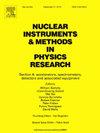The description of the steps of the Q&A test and detector module assembly of the CBM-STS
IF 1.4
3区 物理与天体物理
Q3 INSTRUMENTS & INSTRUMENTATION
Nuclear Instruments & Methods in Physics Research Section A-accelerators Spectrometers Detectors and Associated Equipment
Pub Date : 2024-11-17
DOI:10.1016/j.nima.2024.170081
引用次数: 0
Abstract
The Silicon Tracking System (STS) is the core detector system of the Compressed Baryonic Matter (CBM) experiment at FAIR (Facility for Antiproton and Ion Research). The CBM will study matter at the highest baryonic densities in collisions of nuclear beams with a stationary target. The expected long latency for identification and the changing signature of the events drive us to use self-triggered streaming readout. The CBM data collection will be based on time-stamped detector data into a compute farm. Event reconstruction and physics analysis are performed online at up to 10 MHz collision rates. In the presented work, we will discuss step-by-step how the CBM-STS detector components are rigorously selected and prepared for assembly. It starts with carefully testing the readout ASICs. The various parameters are recorded to select the chip. The next step is to test the micro cable’s TAB (Tape Automated Bonding) bonding quality on the ASIC. Later, the 16-chip cables are bonded to the silicon strip sensor. All test results are stored and available for later use in a specially designed database using custom software applied to each step in the assembly process. After assembly of 1/3 of the modules (896), we will overview the acquired experience.
CBM-STS 的问答测试和探测器模块组装步骤说明
硅跟踪系统(STS)是 FAIR(反质子和离子研究设施)压缩重子物质(CBM)实验的核心探测器系统。CBM 将研究核束流与静止目标碰撞时最高重子密度的物质。由于预期的识别延迟时间较长,而且事件的特征不断变化,因此我们采用了自触发流式读出。CBM 数据收集将基于时间戳探测器数据,并将其输入计算农场。事件重构和物理分析以高达 10 MHz 的碰撞速率在线进行。在介绍的工作中,我们将逐步讨论如何严格选择 CBM-STS 探测器组件并为组装做好准备。首先是仔细测试读出专用集成电路。通过记录各种参数来选择芯片。下一步是在 ASIC 上测试微型电缆的 TAB(胶带自动粘合)粘合质量。随后,将 16 个芯片的电缆粘合到硅带传感器上。所有测试结果都存储在一个专门设计的数据库中,供日后使用,数据库中的定制软件适用于组装过程中的每一个步骤。在组装完 1/3 的模块(896 个)后,我们将对获得的经验进行总结。
本文章由计算机程序翻译,如有差异,请以英文原文为准。
求助全文
约1分钟内获得全文
求助全文
来源期刊
CiteScore
3.20
自引率
21.40%
发文量
787
审稿时长
1 months
期刊介绍:
Section A of Nuclear Instruments and Methods in Physics Research publishes papers on design, manufacturing and performance of scientific instruments with an emphasis on large scale facilities. This includes the development of particle accelerators, ion sources, beam transport systems and target arrangements as well as the use of secondary phenomena such as synchrotron radiation and free electron lasers. It also includes all types of instrumentation for the detection and spectrometry of radiations from high energy processes and nuclear decays, as well as instrumentation for experiments at nuclear reactors. Specialized electronics for nuclear and other types of spectrometry as well as computerization of measurements and control systems in this area also find their place in the A section.
Theoretical as well as experimental papers are accepted.

 求助内容:
求助内容: 应助结果提醒方式:
应助结果提醒方式:


